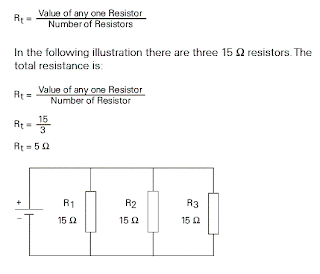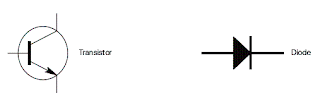A parallel circuit is formed when two or more resistances are placed in a circuit side-by-side so that current can flow through more than one path. The illustration shows two resistors placed side-by-side. There are two paths of current flow. One path is from the negative terminal of the battery through R1returning to the positive terminal. The second path is from the negative terminal of the battery through R2 returning to the positive terminal of the battery.

Formula for Equal Value Resistors in a Parallel Circuit
To determine the total resistance when resistors are of equal value in a parallel circuit, use the following formula:

Formula for Unequal Resistors in a Parallel Circuit
There are two formulas to determine total resistance for resistors of any value in a parallel circuit. The first formula is used when there are any number of resistors.


Voltage in a Parallel Circuit When resistors are placed in parallel across a voltage source, the voltage is the same across each resistor. In the following illustration three resistors are placed in parallel across a 12 volt battery. Each resistor has 12 volts available to it.

Current in a Parallel Circuit
Current flowing through a parallel circuit divides and flows through each branch of the circuit.

Total current in a parallel circuit is equal to the sum of the current in each branch. The following formula applies to current in a parallel circuit.
It = I1 + I2 + I3+ In...
Current Flow with Equal Value Resistors in a Parallel Circuit
When equal resistances are placed in a parallel circuit, opposition to current flow is the same in each branch. In the following circuit R1and R2 are of equal value. If total current (It) is 10 amps, then 5 amps would flow through R1and 5 amps would flow through R2.

Current Flow with Unequal Value Resistors in a Parallel Circuit
When unequal value resistors are placed in a parallel circuit, opposition to current flow is not the same in every circuit branch. Current is greater through the path of least resistance. In the following circuit R1is 40 ohms and R2 is 20 ohms. Small values of resistance means less opposition to current flow. More current will flow through R2 than R1.


Total current can also be calculated by first calculating total resistance, then applying the formula for Ohm’s Law.


























